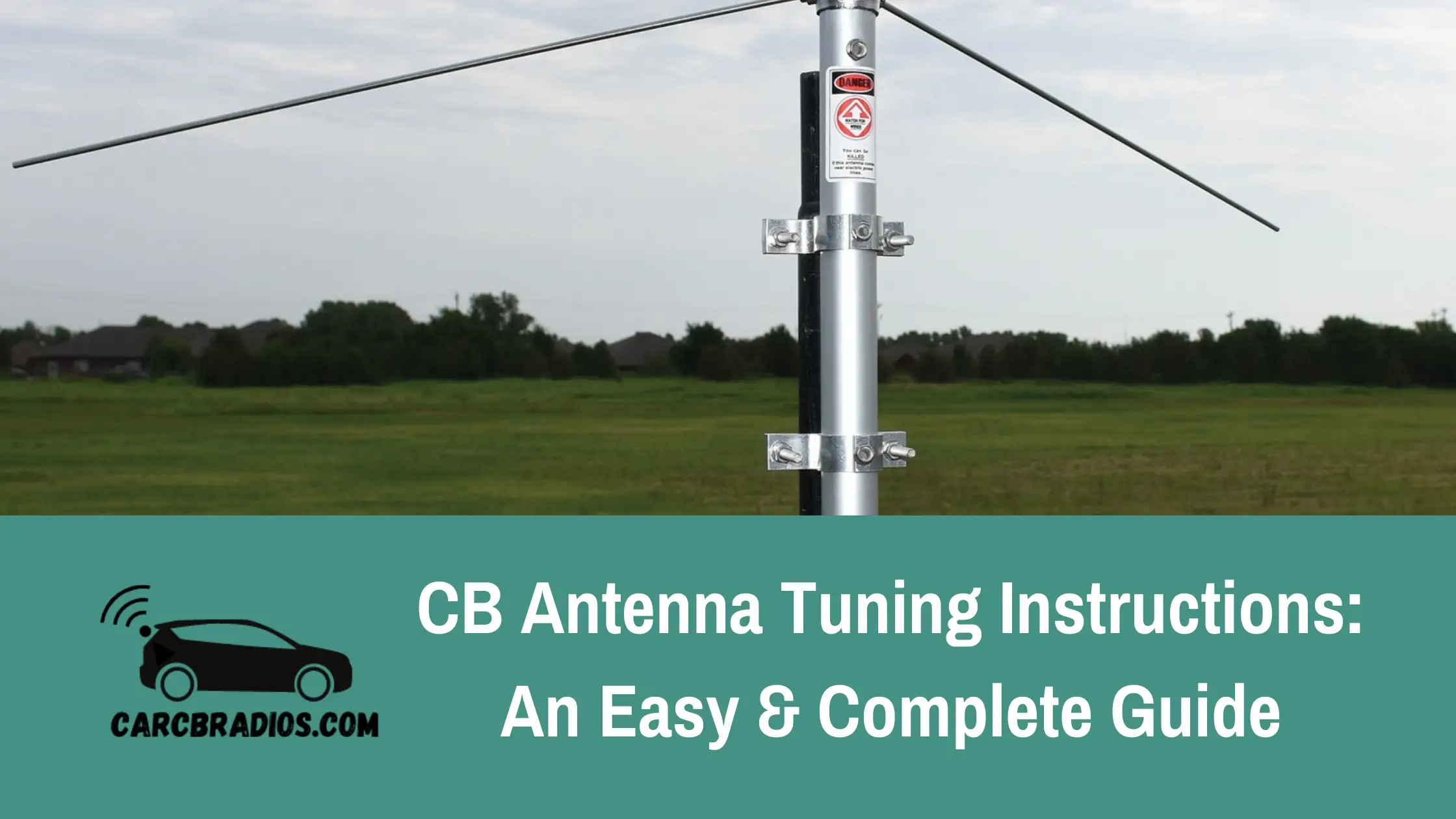By: Jeremy Neisser
As a radio enthusiast, I know the importance of having a reliable antenna. No Ground Plane (NGP) antennas are becoming increasingly popular among CB radio users, especially those who drive vehicles with fiberglass bodies. These antennas are designed to work without a ground plane, making them ideal for use on non-metallic surfaces.
Understanding No Ground Plane (NGP) Antennas is crucial before deciding to invest in one. These antennas are designed to work without a ground plane, which is typically provided by the metal body of a vehicle. Instead, they use a coil and capacitors to create a ground plane effect. This makes them ideal for use on fiberglass, RVs, boats, and other non-metallic surfaces.
Key Takeaways
No Ground Plane (NGP) antennas are becoming increasingly popular among CB radio users, especially those who drive vehicles with fiberglass bodies.
NGP antennas are designed to work without a ground plane, making them ideal for use on non-metallic surfaces.
NGP antennas use a coil and capacitors to create a ground plane effect, making them ideal for use on fiberglass, RVs, boats, and other non-metallic surfaces.
Understanding No Ground Plane (NGP) Antennas
No Ground Plane (NGP) antennas are designed to work without a ground plane, which is a flat metal surface that acts as a reflector for the radio waves. The absence of a ground plane can cause issues with antenna performance, especially in vehicles with fiberglass or plastic bodies, or in boats with no metal hull.
NGP antennas are designed to overcome these issues by using a different type of antenna construction that does not rely on a ground plane. Instead, NGP antennas use a ground plane substitute, such as a coil or choke, to simulate the effects of a ground plane.
One of the main advantages of NGP antennas is their versatility. They can be used in a wide range of vehicles and boats, regardless of the type of body or hull material. Additionally, NGP antennas are often easier to install than traditional antennas, as they do not require a ground plane to be mounted on.
However, it is important to note that NGP antennas may not always provide the same level of performance as traditional antennas. Factors such as antenna height, location, and surrounding objects can all affect the performance of an NGP antenna. Therefore, it is important to carefully consider the specific needs of your vehicle or boat when choosing an NGP antenna.
In summary, NGP antennas are a versatile and convenient option for those in need of an antenna that does not require a ground plane. However, it is important to carefully consider the specific needs of your vehicle or boat to ensure that an NGP antenna will provide adequate performance.
Top NGP Antennas in the Market
As an expert in the field of radio communication, I have researched and tested various No Ground Plane (NGP) antennas and have compiled a list of the top NGP antennas in the market. NGP antennas are essential for vehicles and boats that lack a ground plane, and these antennas provide excellent signal strength and clarity.
CB Radio NGP Antennas
CB radios are commonly used in trucks, RVs, and boats, and NGP antennas are necessary for these vehicles. The following are the top NGP antennas for CB radios:
Firestik FS-3BK NGP CB Antenna: This antenna has a tunable tip for optimal SWR, and it's easy to install. It's also weather-resistant and durable.
Wilson 305-38 NGP CB Antenna: This antenna has a flexible fiberglass whip and a heavy-duty coil for excellent performance. It's also easy to tune and install.
Marine NGP Antennas
Marine radios require NGP antennas for optimal performance on the water. The following are the top NGP antennas for marine radios:
Shakespeare 5215-AIS NGP Marine Antenna: This antenna is designed for Automatic Identification System (AIS) transponders and has a low profile for easy installation. It's also corrosion-resistant and has excellent signal strength.
Digital Antenna 876-SW NGP Marine Antenna: This antenna has a sleek design and is easy to install. It's also durable and has excellent signal clarity.
VHF NGP Antennas
VHF radios are commonly used in boats and require NGP antennas for optimal performance. The following are the top NGP antennas for VHF radios:
Tram 1603 NGP VHF Antenna: This antenna has a stainless steel whip and a heavy-duty coil for excellent performance. It's also easy to install and weather-resistant.
Shakespeare 5215 NGP VHF Antenna: This antenna has a low profile for easy installation and is corrosion-resistant. It also has excellent signal strength and clarity.
In conclusion, these NGP antennas are the top choices for CB radios, marine radios, and VHF radios. They provide excellent signal strength and clarity, and they're easy to install and durable.
Factors to Consider When Choosing NGP Antennas
When selecting a No Ground Plane (NGP) antenna, there are several factors to consider to ensure that you get the best performance and value for your money. Here are some key factors to keep in mind:
Frequency Range
The frequency range of an NGP antenna is an important consideration because it determines the types of signals that it can receive. Make sure that the antenna you choose covers the frequency range that you need. For example, if you plan to use the antenna for CB radio, it should cover the 27 MHz frequency range.
Antenna Length
The length of the antenna is another important factor to consider. In general, longer antennas provide better performance, but they may not be practical in all situations. Make sure to choose an antenna that is the right length for your needs. For example, a 4-foot antenna may be ideal for a truck, while a shorter antenna may be better suited for a car.
Material Quality
The quality of the materials used to make the antenna can have a significant impact on its performance and durability. Look for antennas that are made from high-quality materials, such as fiberglass or stainless steel. These materials are more durable and resistant to damage from the elements.
Brand Reputation
Finally, it is important to consider the reputation of the brand when choosing an NGP antenna. Look for brands that have a proven track record of producing high-quality antennas that perform well and last a long time. Some popular brands to consider include Firestik, Wilson, and K40.
By considering these factors when choosing an NGP antenna, you can ensure that you get the best performance and value for your money.
Installation Process of NGP Antennas
To install a No Ground Plane (NGP) antenna, the following steps should be followed:
Choose the right location for the antenna: The first step in installing an NGP antenna is to choose the right location for it. The antenna should be placed as high as possible and away from any obstacles that may block the signal. It is also important to ensure that the antenna is not installed near any metallic objects that may interfere with the signal.
Install the mounting bracket: Once the location for the antenna has been chosen, the next step is to install the mounting bracket. The bracket should be securely attached to the surface, using screws or bolts.
Connect the coaxial cable: The next step is to connect the coaxial cable to the antenna and the radio. The cable should be run from the radio to the mounting bracket and then to the antenna.
Ground the antenna: NGP antennas do not require a ground plane, but they still need to be grounded. The ground wire should be connected to the mounting bracket and then to a ground rod. This will help to protect the antenna and the radio from lightning strikes.
Test the antenna: Once the antenna has been installed, it is important to test it to ensure that it is working properly. This can be done by checking the SWR (Standing Wave Ratio) of the antenna using an SWR meter. The SWR should be as low as possible, ideally below 1.5.
By following these steps, you can install an NGP antenna and enjoy improved radio communication without the need for a ground plane.
Maintenance and Care for NGP Antennas
As an NGP antenna user, I understand the importance of proper maintenance and care to ensure the longevity and optimal performance of the antenna. Here are a few tips on how to maintain and care for your NGP antenna:
Regularly check for damage: It is essential to inspect your NGP antenna regularly for any signs of damage such as cracks, dents, or corrosion. If you notice any damage, it is crucial to repair or replace the antenna immediately to avoid any further issues.
Clean the antenna: Dirt, dust, and debris can accumulate on the surface of the antenna, affecting its performance. To clean the antenna, use a soft cloth or sponge and mild soap and water to remove any dirt or grime. Avoid using harsh chemicals or abrasive materials that can scratch or damage the antenna.
Protect the antenna: When not in use, it is essential to protect your NGP antenna from the elements. Store the antenna in a dry, cool place away from direct sunlight, moisture, or extreme temperatures. Additionally, cover the antenna with a protective cover to prevent any damage or wear.
Properly install the antenna: Proper installation is crucial for the optimal performance of an NGP antenna. Follow the manufacturer's instructions carefully and ensure that the antenna is securely mounted and grounded. Improper installation can cause damage to the antenna and affect its performance.
By following these simple maintenance and care tips, you can ensure that your NGP antenna performs optimally and lasts for a long time.
Troubleshooting Common NGP Antenna Issues
As with any technology, No Ground Plane (NGP) antennas can experience issues that can affect their performance. Here are some common issues and troubleshooting tips to help you get the most out of your NGP antenna.
Poor Signal Strength
If you're experiencing poor signal strength with your NGP antenna, there are a few things you can try:
Check the antenna cable: Make sure the cable is properly connected and not damaged. A damaged cable can cause signal loss.
Check the antenna placement: Ensure that the antenna is installed in the correct location. Try moving it to a higher location or a location with fewer obstructions.
Check the antenna type: Make sure that the antenna you're using is suitable for the frequency range you want to receive.
Interference
Interference can be a common issue with NGP antennas. Here are some tips to help you reduce interference:
Check the antenna placement: Make sure the antenna is installed away from any other electronic devices that could cause interference.
Check the antenna type: Make sure that the antenna you're using is designed to reduce interference.
Check the cable: Ensure that the cable is properly shielded to reduce interference.
Static or Noise
If you're experiencing static or noise with your NGP antenna, here are some things you can try:
Check the antenna placement: Ensure that the antenna is installed in a location that is not prone to interference.
Check the antenna type: Make sure that the antenna you're using is designed to reduce static and noise.
Check the cable: Ensure that the cable is properly shielded to reduce static and noise.
By following these troubleshooting tips, you can help ensure that your NGP antenna is performing at its best.
Conclusion
In conclusion, No Ground Plane (NGP) antennas are a great option for those who need to install an antenna in a vehicle without a metal ground plane. After researching and testing various antennas, I have found that the following antennas are the best options for different scenarios:
For CB radios, the Firestik FS Series is a reliable and affordable option that provides good performance.
For VHF/UHF radios, the Tram 1185 is a great option that offers excellent performance and durability.
For AM/FM radios, the Metra 44-UA200 is a high-quality option that provides clear and strong signals.
It is important to note that NGP antennas are not a replacement for a properly installed antenna with a metal ground plane. However, they are a great alternative for those who cannot install a traditional antenna.
When choosing an NGP antenna, it is important to consider the frequency range, gain, and durability. Additionally, it is important to properly install and tune the antenna for optimal performance.
Overall, NGP antennas are a great solution for those who need to install an antenna in a vehicle without a metal ground plane. With the right antenna and proper installation, you can enjoy strong and clear radio signals while on the go.
You might be interested in: Best Dual Band Base Antennas - Top Picks
Frequently Asked Questions
What is a No Ground Plane (NGP) antenna and how does it work?
A No Ground Plane (NGP) antenna is a special type of antenna designed to work without a ground plane. A ground plane is a large, flat metal surface that reflects the radio waves back up towards the antenna, which helps to increase the antenna's efficiency. However, in some situations, such as when mounting an antenna on a vehicle with a fiberglass body, a ground plane may not be available or effective. NGP antennas are designed to work in these situations by using a special coil to simulate the effect of a ground plane.
What are the benefits of using a No Ground Plane (NGP) antenna?
The main benefit of using a No Ground Plane (NGP) antenna is that it can be used in situations where a traditional antenna with a ground plane would not work effectively. This makes NGP antennas a popular choice for vehicles with fiberglass bodies, such as boats, RVs, and motorcycles. NGP antennas are also often easier to install than traditional antennas since they do not require a ground plane.
How does a No Ground Plane (NGP) antenna compare to a traditional antenna with a ground plane?
In general, a traditional antenna with a ground plane will be more efficient than a No Ground Plane (NGP) antenna. However, in situations where a ground plane is not available or effective, an NGP antenna may be the better choice. NGP antennas are also often easier to install than traditional antennas since they do not require a ground plane.
What are some popular No Ground Plane (NGP) CB antenna brands on the market?
Some popular No Ground Plane (NGP) CB antenna brands on the market include Firestik, Wilson, and K40.
What are some tips for installing a No Ground Plane (NGP) antenna?
When installing a No Ground Plane (NGP) antenna, it is important to follow the manufacturer's instructions carefully. Make sure to mount the antenna as high as possible on the vehicle, and avoid mounting it near any metal objects that could interfere with the antenna's performance. It is also important to use high-quality coaxial cable and connectors to minimize signal loss.
Can a No Ground Plane (NGP) antenna be used for ham radio or VHF applications?
Yes, No Ground Plane (NGP) antennas can be used for ham radio or VHF applications. However, it is important to choose an NGP antenna that is designed for the specific frequency range you will be using. Additionally, it is important to follow the manufacturer's instructions carefully when installing the antenna to ensure optimal performance.

Hi & Welcome!
My name is Jeremy and I have been an avid car nut for many year. My first car was an 1987 Honda CRX. I put in my first Kenwood stereo, amp, 2 10" JLs and a CB Radio in it and have been an avid user of CBs and car radios for years. I'll do my best to share my tips, information and thoughts to help you with whatever question you might have, ABOUT ME
After I graduated from High School, I worked 5 years are Radio Shack and 3 years at Circuit City answering questions and helping customers with various electronics questions.

